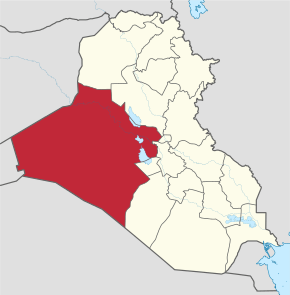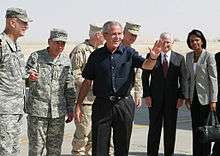Al Anbar Governorate
| Anbar Governorate محافظة الأنبار Anbar Province | |
|---|---|
| Governorate | |
 | |
| Coordinates: 32°54′N 41°36′E / 32.900°N 41.600°ECoordinates: 32°54′N 41°36′E / 32.900°N 41.600°E | |
| Country |
|
| Capital | Ramadi |
| Area | |
| • Total | 138,501 km2 (53,476 sq mi) |
| Population (July 2011 estimate) | |
| • Total | 1,561,407[1] |
Al Anbar Governorate (Arabic: محافظة الأنبار; muḥāfaẓat al-’Anbār), or Anbar Province, is the largest governorate in Iraq by area. Encompassing much of the country's western territory, it shares borders with Syria, Jordan, and Saudi Arabia. The provincial capital is Ramadi; other important cities include Fallujah and Haditha.
The governorate was known as Ramadi up to 1976, when it was renamed Al Anbar Province, and it was known as Dulaim before 1962. Nearly all the inhabitants of the province are Sunni Muslims and most belong to the Dulaim tribe.
In early 2014, the Islamic State of Iraq and the Levant, with the assistance of local Sunni militia, launched a successful campaign to seize control of the province from the Iraqi government. Since then, numerous offensive actions have been undertaken by the Iraqi government to remove ISIL's occupation of the province.
Etymology

The name of the governorate in Persian language means "warehouse" or "silo", from the verb, anbâshtan (to store, to warehouse). This was the last stop/warehouses on the old Silk Road toward Syria. The name is pre-Islamic. The name of the Governorate is taken over from a historic city that was originally located on its territory and whose ruins can still be seen 5 km northwest of Fallujah near the city of Saqlawiyah today. This city of Anbār (Persian: Peruz Shapur) was founded in the 3rd century by the Muntherids, and was before the Arab conquest in 634, the second largest city of Iraq. It was abandoned after the Mongol invasion in the 14th century. A pseudo-authentication is offered by proposing that the name is Arabic and stands for "granaries" in Arabic, further proposing the word Anbar (أنبار) to be the plural of Nbr (نبر) which meaning "grains". In reality, Nbr does not mean grain in classical or middle Arabic, nor commonly in modern Arabic. The name already in use in Pre-Islamic times during the Sasanian rule over Iraq long before any Arabic having introduced to an otherwise Aramaic speaking Iraq.
Dulaim is the old name of the governorate due to the Dulaim tribe inhabiting the region. It was called also called Lwa Al-Dulaim (لواء الدليم) in the Ottoman period and Sanjak Al-Dulaim in the seventeenth century.
Geography

Geographically, Anbar governorate is considered part of the Arabian Peninsula. The region's geography is a combination of steppe around the Euphrates river and true desert, characterised by a desert climate, low rainfall and a large variation in temperature between day and night. Summer temperatures rise to 42 degrees Celsius, whilst in the winter average lows reach 9 degrees Celsius. The northwesterly and southwesterly winds are sometimes to a maximum speed of 21 m/s. Average rainfall in winter to 115 mm.
The most important agricultural crops in Al-Anbar are wheat, potatoes, autumn, barley, maize and vegetables and fodder. There are also a large number of orchards and the province has 2.5 million palm trees. Agriculture depends on perfusion or through the rivers and the wells and the rains.
The Euphrates River flows diagonally from the north to the east, passing through six of the seven districts:
- Al-Qa'im District
- Anah District
- Haditha District
- Hīt District
- Ramadi District
- Fallujah District
- Ar Rutba District
Government
- Deputy Governor: Fuad Jatab Hamad Khalaf al-Karbuli
- Deputy Governor: Hikmat Jassim Zaidon Khalaf al-Mohemdi
- Provincial Council Chairman (PCC): Sabah Karhut al-Halbusi[2]
Population
.jpg)
In the 1920s, the governorate had a population of 250,000, as did Baghdad, out of a total population of 2 million in Iraq. Today there are 9 million people living in Baghdad, among them a million Anbari people in the city and suburbs; their origins are the people of the Al-Anbar tribes that have moved to Baghdad during the past 500 years and their recent migrations there during the 1920s and 1930s.
Half of the residents in Anbar are living on the banks of the Euphrates River outside cities and the towns, there were between 1.9 million and 2 million inhabitants in the districts of Al Anbar.[3] The largest cities are Ramadi (pop. 900,000) and Fallujah (700,000).
| Districts | Population |
| Ramadi | 908,480 |
| Fallujah | 701,354 |
| Heet | 412,414 |
| Al-Qa'im | 370,646 |
| Rutba | 180,118 |
| Haditha | 151,384 |
| Anah | 103,154 |
According to UN estimate in 2003 the population of Al Anbar is 1,230,169.[4] There are no precise estimates of the population which include all of the cities and towns and villages in Anbar. According to a 2003 estimate by the NGO Coordination Committee in Iraq, the population was 1,230,140.
It is estimated that around 90 percent of Anbar's inhabitants are adherents of the Sunni branch of Islam. The remaining ten percent are either Shi'ites or Christians.[5]
Anbar during the United States War in Iraq

The geographic challenge of the Anbar Governorate is demonstrated by two contrasting facts: while it is Iraq's largest governorate, it also is its most sparsely populated. For a governorate that is approximately the size of Bangladesh, it is home to fewer than 1.8 million Iraqis. Most of the population lives in the major cities, like Ramadi and Fallujah, and almost everyone else lives within a short distance of the Euphrates River that snakes from Baghdad to the Syrian Border near Al Qa'im.[6] Its strategic challenge was demonstrated, in part, by casualty statistics. During the first four years of Operation Iraqi Freedom (OIF), the Anbar Province was the deadliest province for American service members, claiming approximately one-third of American fatalities.[6]
In a country where most were associated with the Shi'ia branch of Islam, the Anbar Province was the Sunni stronghold that had long provided Saddam Hussein with the support he needed to remain in power.[6] During the early years of Operation Iraqi Freedom, it provided an important base for Al Qaeda and insurgent operations.[6] Part of its significance came from the fact that the Western Euphrates River Valley served as an important infiltration route for foreign fighters headed to Iraq’s heartland.[6] The New York Times compared this region to the Vietnam War’s Ho Chi Minh Trail, as foreign fighters and insurgents used the river valley to move in relative safety from the Syrian border to cities like Baghdad, Ramadi and Fallujah.
The contrast between the fertile Euphrates River Valley and the rest of the province is striking. Along the Euphrates, groves of fruits and vegetables and acre after acre of date palms are surrounded by a lushness that paints the area a vivid green. Just a few miles from the Euphrates, however, the barren landscape turns brown. With the exception of an occasional Bedouin, the desert is essentially empty. Whether traveling by aircraft, vehicle, or on foot, the Anbar Governorate is vast. During a time when mining roads became a strategy of choice for insurgents, the need to patrol and travel throughout the province became one of the Marine Corps’ greatest challenges. The threat of insurgent activity, when combined with the challenges that long-distance travel, choking dust, and stifling heat created, made the Anbar Province a difficult area of operation.[6]
Cities and towns
|
|
See also
- Anbar campaign (2013–14)
- Al-Anbar governorate council election, 2005
- Abdul Sattar Buzaigh al-Rishawi
- Anbar Awakening
- First Battle of Fallujah
- Operation Phantom Fury
- Battle of Ramadi
- Battle of Haditha
References
- ↑ Citypopulation.de
- ↑ "Chairman of Anbar Council rejects the Governor's call for the Army return to cities". National Iraqi News Agency. 2014-01-01.
- ↑ Parfit, Joseph T. (1920). Marvellous Mesopotamia, The world's wonderland. London: S. W. Partridge & co., ltd. p. 15.
- ↑ UN Data 2003
- ↑ "Irakische Streitkräfte starten Rückeroberung Ramadis". Deutsche Welle. Retrieved 2015-05-26.
- 1 2 3 4 5 6 "Archived copy" (PDF). Archived from the original (PDF) on 2012-09-15. Retrieved 2012-07-25.
